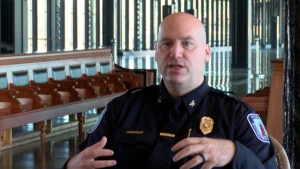
by Dick Hall-Sizemore
A recent article in the Richmond Times-Dispatch brings news that contravenes two themes prevalent in Bacon’s Rebellion: the rising violent crime rate and the ineffectiveness of the Richmond city government.
Despite having a police force with a vacancy rate of 20%, Richmond has seen a 35% drop in homicides and nearly a 20% drop in armed robberies in 2022. The Richmond police department’s strategy for helping to achieve these reductions was simple and commonsensical: put the cops where there is likely to be trouble.
Rick Edwards, now the interim police chief, instituted a gun violence reduction program last summer. He first asked analysts in the department to identify gun violence “hot spots.” Those were defined as one to three-block areas in which there were a lot of murders, non-fatal shootings, robberies, shooting into occupied dwellings, and shootings into occupied cars. He contends that those last two items are “indicators of future murders.”
After identifying the 25 hot spots with the highest rates of those violent crimes, police officers in the precincts in which the hot spots were located were directed to stop by every day for 10 or 15 minutes randomly during the hours that analysts found the violent crimes tended to occur. Furthermore, they were not to just drive through those areas. The officers were directed to get out of their cars and talk to people.
The strategy had two effects. First, the presence of cops caused criminals to change their behavior. It also enabled citizens to see police officers around and feel safer.
The strategy also had tangible results. Tracking calls from citizens for police officers after each hot spot visit, analysts found that things quieted down for a few hours. In the 1st precinct, which had 19 of the 25 top hot spots, there was a 73% drop in homicides and a 13% drop in non-fatal shootings. When he became the interim chief this fall, Edwards expanded the gun violence reduction program to cover all precincts. Each precinct will be making daily checks on its 10 hot spots.
Unlike the decrease in gun violence offenses, property crime in the city has increased by 25%. The main factor in that overall increase has been a 41% increase in stealing motor vehicles and stealing stuff from parked motor vehicles. The use of common sense by citizens would go a long way to reducing these incidents: Don’t leave your keys in your car, and lock your car when it is parked.
Edwards seems to understand that it is important that citizens feel safe and sometimes it is simple things that can achieve that. He tells the story of when he was a lieutenant covering one of the city’s public housing areas. He was giving a talk to residents and spouting off statistics about reductions in this and that and folks’ eyes were glazing over. After the talk, an older woman pulled him over and said, “That’s great, but if you can do something about me walking from my car to my apartment and not having to see young men with their guns standing there.” Edwards followed up and discovered that the spot was a drug market, guarded by armed men, that the patrols had not picked up on. So, he put up a camera. Problem solved.

Leave a Reply
You must be logged in to post a comment.